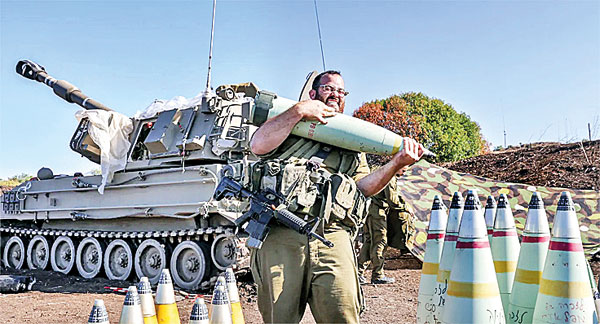Sunday Times 2
Israel’s hefty military might heavily fortified by US weapons systems
View(s):By Thalif Deen
UNITED NATIONS–The ongoing battle between Israel and Hamas is overwhelmingly one-sided—the most powerful military in the Middle East, armed with some of most sophisticated and state-of-the-art American weapons systems vs a militant force armed largely with shoulder-borne rocket launchers, mortars, drones and small arms.
Adding more to its devastating firepower, Israel is also the only nuclear power in the Middle East, joining the ranks world-wide of UK, the US, France, Russia and China, along with India, Pakistan and North Korea.
When Israeli Prime Minister Benjamin Netanyahu last week warned Hamas to “Get Out Now”, he vowed to unleash “the full force of Israel’s military”.

An Israeli soldier carries US supplied 155mm shells. AFP
But that military might is heavily fortified—and subsidized—by the United States which has provided billions of dollars in American weapons, funded mostly with outright military grants, credits and financing.
Besides successive US administrations, that unyielding support also comes from the United States Congress best described “as Israeli-occupied territory”. Forget Gaza, East Jerusalem and the West Bank.
Zain Hussain, a Researcher in the Arms Transfers Programme at the Stockholm International Peace Research Institute (SIPRI) told IDN that US foreign policy towards Israel involves the supply of foreign military financing (FMF) and arms to Israel.
Currently, there is a 10-year bilateral military aid memorandum between the US and Israel, which commits the US to providing Israel with USD 3.3 billion in Foreign Military Financing, and to spend USD 500 million every year in joint missile defence programmes between FY2019 and FY2028.
The US, he said, is committed to helping Israel uphold its qualitative military edge, and does this through long-term commitments to military aid and cooperation, and supplying arms in times of conflict.
In an analytical piece on October 13, Elias Yousif, a Research Analyst with the Washinton-based Stimson Center’s Conventional Defence Programme and Rachel Stohl, Vice President of Research Programmes and Director of the Conventional Defence Programme, point out that Israel is the largest cumulative recipient of U.S. military assistance since the Second World War, amounting to more than $158 billion over the past seven decades– not adjusted for inflation.
Though U.S. security assistance to Israel takes many forms, the largest portion comes through Foreign Military Financing (FMF), which are grants to support the purchase of U.S. defence articles and services.
The current MoU commits the United States to $3.3 billion in annual FMF to Israel, the largest routine FMF package the United States provides on a yearly basis and which alone represents approximately 16% of Israel’s defence budget.
According to SIPRI, US arms supplies to Israel between 2013 and 2022, include the following:
Aircraft (including fighter planes and combat helicopters):
F-35 Stealth multirole fighter/combat aircraft – Estimated 36 delivered.
F-15A/C Eagle F-15E Strike Eagle combat aircraft – Estimated delivery of 9 between 2013 and 2023 (estimated delivery of 115 in total).
Before 2013, there were some imports of relevant aircraft which are either of importance or may currently be being used by Israel:
Boeing AH-64 Apache combat helicopter – Estimated 63 delivered.
S-70 Black Hawk – We have confirmed deliveries of 49 Black Hawk transport helicopters.
F-16A/C/I Fighting Falcon – Estimated 362 delivered.
Missiles and bombs:
JDAM guided bombs – Estimated almost 9000 delivered between 2013 and 2022 (total estimated 18000)
Small Diameter Bombs – estimated 7500 delivered (estimated total of 9000 overall)
Other missiles delivered before 2013 which are still of interest are AGM-114A/K/L the Hellfire missiles (estimated 1455 delivered)
Armoured vehicles:
·M-113 Armoured Personnel Carriers (APCs)– approximately 300 delivered between 2013 – 2022
Namer APCs/Infantry Fighting Vehicles – estimated 386 delivered between 2013 and 2022
Regarding drones, Israel’s own drone capabilities are very advanced. Israel’s arms industry continues to supply Israel with air defence weapons, artillery and advanced rocket launchers, among other important capabilities, said SIPRI’s Hussain.
According to Yousif and Stohl of the Stimson Centre, Israel also has unique privileges in how it uses its FMF funding. Israel is eligible for “Cash Flow Financing,” which allows it to use FMF to finance multiyear purchase without having to pay for acquisitions entirely up-front.
Additionally, Israel has also been permitted to spend FMF appropriations on Israeli weaponry, a practice that is being phased out in the current MoU but has historically pumped hundreds of millions of U.S. dollars into the Israeli defence industry.
Israel is also permitted to use FMF to purchase armaments directly from U.S. manufacturers using the direct commercial sales process, and also enjoys expedited Congressional review periods for its arms packages.
In addition to FMF, Israel also receives U.S. assistance for joint missile defence development. The current MoU pledges $5 billion over the life of the arrangement for various missile defence programmes that are often developed or produced with U.S. firms.
This includes investments in Israel’s much vaulted Iron Dome short range air defence system, as well as other longer-range platforms like Arrow II, Arrow III, and David’s Sling. Between FY2006 and FY2023, the United States has appropriated more than $8.6 billion for various U.S-Israeli missile defense programmes.
Beyond the direct support the United States provides to Israel, U.S. regional security cooperation is also aimed at maintaining Israel’s “qualitative military edge,” (QME) a term which refers to the technical sophistication of Israel’s defence equipment vis-à-vis its neighbours.
Although originally an informal commitment, successive administrations and Congressional actions have codified U.S. support for Israel’s QME, including measures like allowing Israel first regional access to U.S. defende technology or more advanced versions of systems provided to other regional partners.
(Thalif Deen, editor-at-large at the Berlin-based In-Depth News (IDN) Service, was a former Director, Foreign Military Markets at Defense Marketing Services; Senior Defense Analyst at Forecast International; and military editor Middle East/Africa at Jane’s Information Group, USA.)
Courtesy In-Depth News

